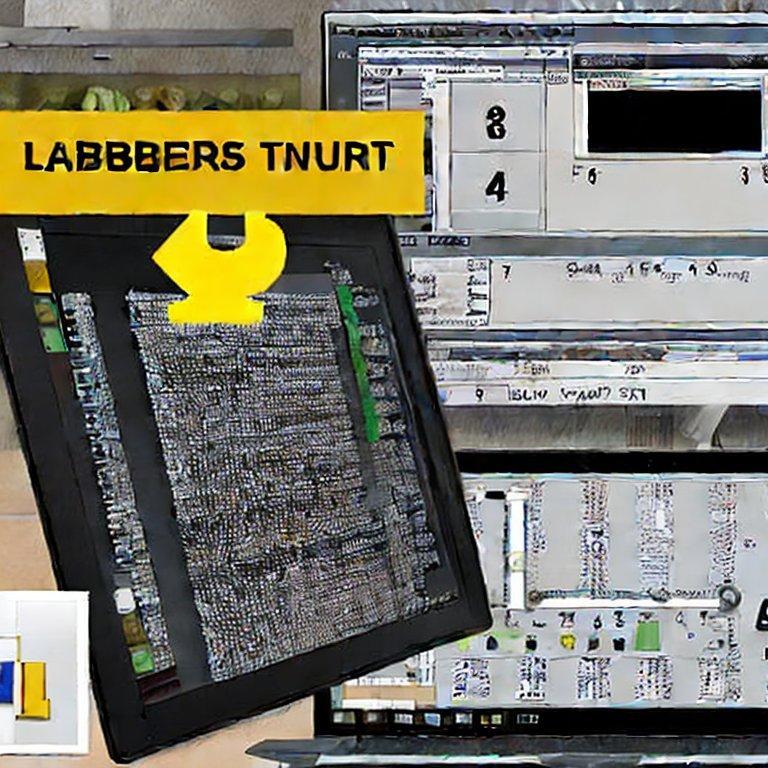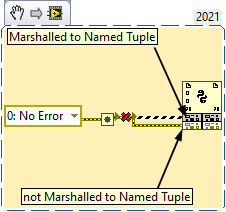-
Posts
440 -
Joined
-
Days Won
29
Content Type
Profiles
Forums
Downloads
Gallery
Everything posted by X___
-
Take an Open Python Session Node, pass an error cluster with a non-zero error code (but otherwise status = FALSE and empty Source string), connect the outputs to a Python Node (and use a Close Python Session node if you want afterwards). Run. The Open Session Node transmits the warning (so doesn't generate an error) but the following Python Node converts the warning into an error (same code, TRUE status and source = Python Node in Calling VI name). That is unexpected.
-
Another interesting tidbit: you cannot "Find All Instances" of an error ring. And you cannot search for an error code (or an error message for that matter) and expect error rings to be returned as part of the search results. The error rings live in a separate...ring (the mathematical structure). Yet, they are pretty much indispensable if you use custom error codes...
-
The snippet below shows some oddity I uncovered while trying to document a bit of code involving the Python node. The error constant is just here to provide a cluster input to the node (which is what the "Marshal to Named Tuples" is supposed to handle). The Always Copy node is here to go around the known problem that the comment arrow will snap to the middle of the wire it is attached to, NOT where the user connects it to the wire (and that of course will never change). The comments indicate that the first node input (which happens to be the return argument, but that has no bearing o the observed behavior) has been right-clicked and "Marshal to Named Tuples" was used. By contrast, the second node input has had no modification applied. The result (surprising to me) of the "Marshal to Named Tuples" option was that the wire broke, as if the node lost its ability to "read" the cluster element names. Obviously no such thing happens when making a copy of anything (you can still hover over the lower branch of the wire with a probe and the Help window will show all 3 cluster element names). I am erring on the side of calling this a bug, but it might just be some kind of arcane feature of the node which only its author is familiar with (and I don't really whether or not it changes in the future since I am dug in 2021 SP1). But here it is for every one to gawk at.
-
- always copy
- python node
-
(and 1 more)
Tagged with:
-
Forgot the "dark humor" flag/emoji.
-
https://community.openmainframeproject.org/c/cobol-technical-questions/16 Looks familiar?
-
It's not a general purpose programming language.
-
The relative difference between the two appears to decrease with the size of the array, suggesting this is an initialization step (sanity checks) issue. On my machine: N | no String Conversion | with String Conversion | -------------------------------------------------------------- 10 | 750 ns | 400 ns | 100 | 700 ns | 1000 ns | 1000 | 5600 ns | 5100 ns | So approximately 300 ns more for the no String Conversion case, which becomes a negligible difference for large array. I would argue that large arrays are more common in this type of conversion tasks, but this is interesting to know regardless. I would also argue that there are vastly more irritating oldies in the LabVIEW code base that would deserve attention, but we know how that flies in Austin.
-
I would find this related post kinda funny: https://forums.ni.com/t5/LabVIEW/how-to-associate-a-license-with-my-NI-account/td-p/4256133 if a colleague of mine had not reported the exact same problem of a suddenly expiring permanent license (for the 2021 Vision Development runtime). The response she got was "they are refusing to reactivate it or even explain why it was deactivated in the first place". It looks like a class action lawsuit in the making. Any lawyers reading this?
-

Matlab Script Node doesn't update when .m file edited externally
X___ replied to Pat O's topic in Calling External Code
13 years later, this is still not documented in LabVIEW. And since in the meantime the Matlab node has also changed, you now need to reate a little "ClearAll.m" Matlab helper script that contains: function ClearAll() clear functions end and call it before your node of interest when developing... -
It took me a handful of calls before I found one person who was willing to take up the case. It's been such a long time since I got some really helpful support from NI that I am starting to believe in a miracle (I forgot to mention that I was provided temporary activation codes for the different computers and software packages I needed to work. Those expire in a couple of weeks, so I may end up with a complete meltdown again). If that guys quits on me or is fired, I am afraid I am running out of options. I guess what saves NI from having my university on their neck is that no-one is pretty much using LabVIEW anymore? Meanwhile NI is offering $100 for 1-on-1 Teams calls for users to help them improve their docs and publishes a roadmap with two columns: soon and later. The ambition is bursting at the seams...
-
Update on "disappearing" permanent license. Well, there is at least one helpful person at NI, and I was lucky enough to find him... Long story short (this has been going on since my last post on the topic, more than 2 weeks ago) NI screwed up internally (or, a possibility that was cautiously hinted at, the licensing code is buggy) and voided our permanent license. After (presumably) some testing, they haven't been able to fix the problem and offered me to: 1) exceptionally issue a new permanent license number that will replace our voided one. 2) escalate the issue to the R & D team to figure it out (the hint I was referring to). I chose 1 after having strongly suggested they go for 2) anyway, as I (we) can't be the only one affected. It also turned out that they screwed up our license renewal (i.e. the migration to an annual academic subscription license) and gave our Department a quote for a one month (!) license, soon to expire. I don't really care about that one, as I have no intention to upgrade, but just sayin'... There is truly something rotten in the State of Denmark.
-

Let’s make Machine Learning easy with scikit-learn on LabVIEW
X___ replied to Youssef Menjour's topic in LabVIEW General
You have two very similar threads on this forum, which makes it difficult to have a linear discussion: https://lavag.org/topic/22489-let%E2%80%99s-make-deep-learning-easy-with-haibal-library-on-labview/#comment-142891 We all agree that graphical programming has tons of advantages over pages of text code. However, most of us hate to be arm-twisted in having to pay annually for new versions of a language that fixes bug at a snail pace (if ever), release features that take 2 to 3 versions to work as advertised, and is offering abysmal level of technical support (and the list of recriminations could go on and on). Your toolkit looks truly amazing, but I would argue that you are not alone in having invested massive amount of time and effort in G-code. Yet, some of us who have, have come to the conclusion that we cannot reasonably tie our work to NI's whim and suicidal plans for LabVIEW. I have decided to migrate as fast as I can to Python. I'd argue that someone who is willing to do so (migrate to Python) will find the resources to master the basics of DL in Python, not mentioning that you'll have to keep running to stay on top of the new developments in the field with your toolkit. How you can hope to do that for free is a mystery to me. As I said, admirable, but a tad idealistic... Sorry for being he bearer of bad news, but "un homme averti en vaut deux", as the French say.- 16 replies
-
- 2
-

-

-
- labview
- machine learning
-
(and 3 more)
Tagged with:
-
To tell you the truth, right now I am feeling owned for not being able to open LabVIEW 2021 SP1 after having installed it in December 2021 under a "permanent" Academic License (idem for the Vision Development Module). I am being told there never was such a thing as a permanent academic license. Oh yeah? So why can I open my LabVIEW 2019 SP1 and LabVIEW 2018 SP1 versions installed with the same license number on the same machine? I forgot to say that another NI employee I was talking with today (I talked with three, not including the Newark guy) told me that this was impossible because an academic license was only supposed to allow using the latest version of LabVIEW. Needless to say, she had nothing to answer to my explaining what I just said in the previous sentence (that is that I was running TWO old versions simultaneously). So far, I haven't talked to a single NI employee who seemed to really know what they were talking about. It's absolutely all downhill and I have absolutely zero trust in this company. Stock is doing great though, so the smokescreen and psychedelics are doing wonders.
-
BTW, if someone still believe that a debug and deployment license will allow them to develop software, they need to wake up or prove that this is the case. According to the NI home employees (and beyond, see below) I talked to, that is not the case. For LabVIEW, for Vision Development Module, etc. True, these are PERMANENT licenses, but you can't do much with them. The funny part is that a guy from Newark (the company that distributed NI product, to which NI sales transferred me to get additional information - this gets better by the hour) tried to explained to me that with a debug and deployment license, you cannot develop new code, but you can debug and fix a released executable (exe file). I asked him how that would work and then thanked him very much. 😭
-
I wished I could be as excited as this deserves, but with the abysmal transformation of NI in a money machine making it impossible to get support for something as simple re-activating a permanent license, I am on my way to Python...
- 7 replies
-
- deeplearning
- pytorch
-
(and 3 more)
Tagged with:
-
As part of their 100-year of "Engineer Ambitiously" TM "at your speed", NI has in fact implemented a very clever strategy to motivate people from migrating away from their products: make permanent license re-activatable every year and make the reactivation process completely opaque or downright impossible. The idea is that after a few frustrating phone calls ending in the connecting ending in prolonged silence after an attempted "transfer" with tech support, you are supposed to give up and write off 25+ years of code development using a desperately closed and outdated language to finally embrace the open source Now tech support is working from home, so they are probably free to decide that they won't pick up calls, or maybe the call routing system at NI is hopelessly rotten (dropped calls appear to be systematic), but this problems would not exist in the first place if permanent licenses were really what their name indicate. This is not just me saying that: https://lavag.org/topic/22538-labview-activation-issues/ I am not in a mood or position to file a lawsuit, but this is erring on the side of commercial deception...
-
Just don't hold your breath.
-
Make it ten...
-
I thought that was the first... at least according to popular secular tradition: link I guess this is the old question of which one came first of the hen and the egg...
-
Actually the original is quite possibly funnier: Oh, and there is a second version of it: and even a Wikipedia page with very interesting background information: https://en.wikipedia.org/wiki/Turbo_encabulator
-
I've got to ask: what is the second oldest?
-
He that is without CIN among you, let him be the first to cast a stone at her
-
I will grant this to NI: they use real blood and flesh employees, not bots (yet). The second employee I talked with to get to the bottom of NI's price gouging policy was just as detached from logic and reality as the first one (with the excuse that his kids were causing a ruckus in the background, so that added to the stress of dealing with a frustrated customer). According to that employee, I should provide a copy of an academic quote from the past to even listen to my claim that the VDM DL academic version used to cost $110 in 2019. Never mind that I felt this was important enough to write down this information on my software release website at the time, emphasizing the differential with the regular price... Not only that, but (according to this employee) the new policy of NI is to grant academia a systematic discount of 10%. Which does explain the $407.40 vs $582 current price differential...not (I didn't bother to bring up the discrepancy I noticed across two NI webpages, see previous post). Before that, I had to listen to a discombobulated speech about the new subscription policy and its justification by the included technical support, which has obviously zero bearing on a deployment license, which grants no support right to a user of an executable not developed by NI. Of course, I did not get any answer to my question about the reason why the differential between academic licenses and regular license went from a 1 to 4 ratio to a 1 to 1.4 ratio. Clearly, I should not be expecting a front line employee possibly getting entry level wages to justify why the corporate sharks instructed their minions to raise all prices to milk as much revenue as possible to sustain their own salary and compensation increases and shareholder returns. I wonder whether NI has considered recruiting Martin Shkreli or just decided to follow his business model... I then asked how I could lodge a complaint and whether I could have a case number to refer to when sending that complaint. Aside from almost having to arm twist the guy to get the customerservice@ni.com email, I learned that, for price quote, there is no information asked from the complaining customer, no case number is opened, and it is up to the employee to send feedback to their management. In other words, NI is not expecting any customer to complain about quotes. I am suspecting they are up for some surprises. My feeling is that the software division of NI has been granted the status of "business unit" and is tasked to generate revenue to justify its existence. Good luck with that... The "agile" software development jargon is a marketing ploy justifying the release of minor updates as full-fledged versions (e.g. 2022). Not that it is a radical change from previous years as far as the product itself goes, but it certainly is as far as pricing. The head of that strategy? Shelley Gretlein: https://www.ni.com/en-us/about-ni/leadership/gretlein.html "Shelley Gretlein is focused on empowering NI’s broadest set of customers", which means there is a fringe that is not supposed to be empowered (less power to them!) and that fringe is clearly those who refuse to pay for a periclitating software at inflated price (aka not big corporations). "She led one of the most successful rebrands in the test and measurement market." That, I am not quite sure what it refers to. The failure of NXG? The move to a subscription scheme? Something else? Of course, this type of sentence does not even need to refer to anything. It just needs to use bombastic qualifiers. I'll leave it to you to read this masterpiece of a corporate double-speak. My bet for NI's next move? Offer their service to VW to save them from their software development failure: https://www.theregister.com/2022/07/26/from_beetles_to_bugs_vw/


